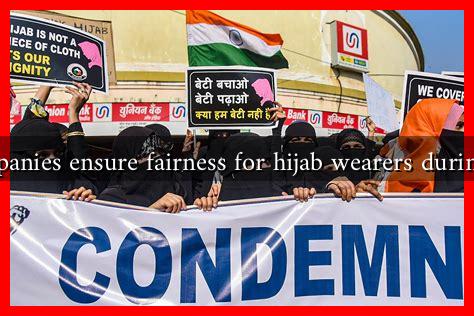-
Table of Contents
- How Can Companies Ensure Fairness for Hijab Wearers During Evaluations?
- Understanding the Challenges Faced by Hijab Wearers
- Strategies for Ensuring Fair Evaluations
- 1. Implement Bias Training
- 2. Standardize Evaluation Criteria
- 3. Foster an Inclusive Culture
- 4. Monitor and Evaluate Outcomes
- Conclusion
How Can Companies Ensure Fairness for Hijab Wearers During Evaluations?
In today’s diverse workplace, ensuring fairness for all employees, including hijab wearers, is crucial for fostering an inclusive environment. The hijab, a headscarf worn by many Muslim women, can sometimes lead to biases during performance evaluations. Companies must take proactive steps to ensure that these biases do not affect the assessment of hijab wearers. This article explores effective strategies that organizations can implement to promote fairness and equity in evaluations.
Understanding the Challenges Faced by Hijab Wearers
Before delving into solutions, it is essential to understand the challenges hijab wearers face in the workplace. These challenges can include:
- Implicit Bias: Evaluators may unconsciously harbor biases against individuals who wear hijabs, affecting their judgment.
- Stereotyping: Hijab wearers may be stereotyped as less competent or less committed to their jobs.
- Isolation: Hijab wearers may feel isolated or marginalized in predominantly non-Muslim environments.
According to a study by the Institute for Social Policy and Understanding, 67% of Muslim women reported experiencing discrimination in the workplace, highlighting the need for companies to address these issues head-on.
Strategies for Ensuring Fair Evaluations
To create a fair evaluation process for hijab wearers, companies can adopt several strategies:
1. Implement Bias Training
Training programs focused on unconscious bias can help evaluators recognize and mitigate their biases. These programs should include:
- Workshops on cultural competency and diversity.
- Interactive sessions that challenge stereotypes and promote empathy.
- Regular assessments to measure the effectiveness of training.
For example, Google has implemented bias training for its employees, resulting in a more inclusive workplace culture.
2. Standardize Evaluation Criteria
Establishing clear and standardized evaluation criteria can help minimize subjective judgments. Companies should:
- Develop a comprehensive rubric that outlines performance metrics.
- Ensure that all employees are evaluated based on the same criteria, regardless of their appearance.
- Incorporate feedback from multiple sources to provide a well-rounded assessment.
By standardizing evaluations, companies can reduce the impact of personal biases on performance reviews.
3. Foster an Inclusive Culture
Creating an inclusive workplace culture is vital for supporting hijab wearers. Companies can promote inclusivity by:
- Encouraging open dialogue about diversity and inclusion.
- Celebrating cultural events and recognizing the significance of the hijab.
- Providing mentorship programs that connect hijab wearers with leaders in the organization.
For instance, Accenture has made significant strides in promoting diversity and inclusion, resulting in a more supportive environment for all employees.
4. Monitor and Evaluate Outcomes
Regularly monitoring and evaluating the outcomes of performance evaluations can help identify any disparities. Companies should:
- Collect data on evaluation scores across different demographics.
- Analyze trends to identify potential biases in the evaluation process.
- Adjust policies and training programs based on findings to ensure continuous improvement.
By actively monitoring outcomes, companies can hold themselves accountable and make necessary adjustments to promote fairness.
Conclusion
Ensuring fairness for hijab wearers during evaluations is not just a moral obligation; it is essential for fostering a diverse and inclusive workplace. By implementing bias training, standardizing evaluation criteria, fostering an inclusive culture, and monitoring outcomes, companies can create an environment where all employees feel valued and respected. As organizations continue to embrace diversity, it is crucial to recognize and address the unique challenges faced by hijab wearers, ultimately leading to a more equitable workplace for everyone.
For further reading on workplace diversity and inclusion, you can visit DiversityInc.

